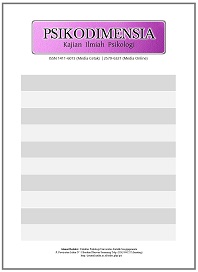The Influence of Perceived Maternal Warmth toward Empathy among Urban Adolescents from Low Socio-Economic Status Family
Abstract
Keywords: adolescent; empathy; maternal warmth; poverty.
Keywords
Full Text:
PDFReferences
Allemand, M., Steiger, A. E., & Fend, H. (2015). Empathy development in adolescence predicts social competencies in adulthood. Journal of Personality, 83(2), 229-241.
Andriani, A., & Listiyandini, R. A. (2017). Peran Kecerdasan Sosial Terhadap Resiliensi Pada Mahasiswa Tingkat Awal. Psympathic: Jurnal Ilmiah Psikologi, 4(1), 67-90.
Arzeen, S., Hassan, B., & Riaz, M. N. (2002). Perception of parental acceptance and rejection in emotionally emphatic and non-empathic adolescents. Pakistan Journal of Social and Clinical Psychology, 10(2), 60-69.
Badan Pusat Statistik. (2019). Jumlah penduduk miskin menurut provinsi. https://www.bps.go.id/linkTableDinamis/view/id/1119, diunduh pada tanggal 27 April 2020.
Bodovski, K., & Youn, M. J. (2010). Love, discipline and elementary school achievement: The role of family emotional climate. Social Science Research, 39(4), 585-595.
Bøe, T., Sivertsen, B., Heiervang, E., Goodman, R., Lundervold, A. J., & Hysing, M. (2013). Socioeconomic Status and Child Mental Health: The Role of Parental Emotional Well-Being and Parenting Practices. Journal of Abnormal Child Psychology, 42(5), 705–715.
Cheah, C. S. L., Leung, C. Y. Y., Tahseen, M., & Schultz, D. (2009). Authoritative parenting among immigrant Chinese mothers of preschoolers. Journal of Family Psychology, 23(3), 311–320.
Dahl, G. B., & Lochner, L. (2012). The Impact of Family Income on Child Achievement: Evidence from the Earned Income Tax Credit. American Economic Review, 102(5), 1927–1956.
Dashiff, C., DiMicco, W., Myers, B., & Sheppard, K. (2009). Poverty and adolescent mental health. Journal of Child and Adolescent Psychiatric Nursing, 22(1), 23-32.
Davis, A. N., & Carlo, G. (2019). Maternal warmth and prosocial behaviors among low-SES adolescents: Considering Interactions between empathy and moral conviction. Journal of Moral Education, 1–15.
DeRose, L. M., & Brooks-Gunn, J. (2009). Pubertal development in early adolescence: implications for affective processes. In Allen, N. B., & Sheeber, L. B. (Eds). Adolescent emotional development and the emergence of depressive disorders (pp 56-73). Cambridge, UK: Cambridge University Press.
Eisenberg, N., Eggum, N. D., & Di Giunta, L. (2010). Empathy-related responding: associations with prosocial behavior, aggression, and intergroup relations. Soc Issues Policy Rev, 4(1), 143–180.
Ernawati, E. (2012). Hubungan Antara Peran Ibu, Peran Ayah Dan Kepercayaan Diri Dengan Penyesuaian Sosial Remaja. (Doctoral dissertation, Universitas Muhammadiyah Surakarta).
Feldman, R., Gordon, I., Schneiderman, I., Weisman, O., & Zagoory-Sharon, O. (2010). Natural variations in maternal and paternal care are associated with systematic changes in oxytocin following parent–infant contact. Psychoneuroendocrinology, 35(8), 1133–1141.
Feldman, R., Magori-Cohen, R., Galili, G., Singer, M., & Louzoun, Y. (2011). Mother and infant coordinate heart rhythms through episodes of interaction synchrony. Infant Behavior and Development, 34(4), 569–577.
Fourianalistyawati, E., Listiyandini, R. A., & Fitriana, T. S. (2016). Hubungan Mindfulness dan Kualitas Hidup Orang Dewasa. Prosiding Forum Ilmiah Psikologi Indonesian (FIPI). Fakultas Psikologi Universitas Tarumanegara.
Garaigordobil, M. (2009). A comparative analysis of empathy in childhood and adolescence: Gender differences and associated socio-emotional variables. International Journal of Psychology and Psychological Therapy, 9(2), 217-235.
Gonzales, N. A., Coxe, S., Roosa, M. W., White, R. M. B., Knight, G. P., Zeiders, K. H., & Saenz, D. (2010). Economic Hardship, Neighborhood Context, and Parenting: Prospective Effects on Mexican-American Adolescent’s Mental Health. American Journal of Community Psychology, 47(1-2), 98–113.
Guo, Q., & Feng, L. (2017). The associations between perceived parenting styles, empathy, and altruistic choices in economic games: A study of Chinese children. Frontiers in psychology, 8, 1843.
Kau, M. A. (2010). Empati dan perilaku prososial pada anak. Jurnal INOVASI, 7(3), ISSN 1693-9034.
Karela, C., & Petrogiannis, K. (2018). Risk and Resilience Factors of Divorce and Young Children’s Emotional Well-Being in Greece: A Correlational Study. Journal of Educational and Developmental Psychology, 8(2), 2.
Khaleque, A. (2013). Perceived parental warmth, and children’s psychological adjustment, and personality dispositions: A meta-analysis. Journal Child Family Stud, 22(2), 297-306.
Larson, R. W., & Sheeber, L. B. (2009). The daily emotional experience of adolescents: are adolescents more emotional, why, and how is that related to depression?. In Allen, N. B., & Sheeber, L. B. (Eds). Adolescent emotional development and the emergence of depressive disorders (pp 11-32). Cambridge, UK: Cambridge University Press.
Leung, J. T. Y., & Shek, D. T. L. (2011). Poverty and adolescent development outcomes: A critical review. International Journal Adolescence Med Health, 23(2), 109-114.
Leventhal, T., & Brooks-Gunn, J. (2011). Changes in neighborhood poverty from 1990-2000 and youth’s problem behaviors. Developmental Psychology, 47(6), 1680.
Listiani, D. (2013). Hubungan antara pola asuh demokratis orang tua dengan empati pada remaja. MOTIVASI, 1(1).
Lord-Kambitsch, E. (2014). Introduction to empathy: activation, definition, construct. Think Pieces: A Journal of the Arts, Humanities, and Social Sciences, 1(1), 1-8.
Masten, C. L., Eisenberger, N. I., Pfeifer, J. H., & Dapretto, M. (2010). Witnessing peer rejection during early adolescence: Neural correlates of empathy for experiences of social exclusion. Social Neuroscience, 5(5-6), 496-507.
McDonald, N. M., & Messinger, D. S. (2011). In A. Acerbi, JA Lombo, & JJ Sanguineti (Eds), Free will, Emotions, and Moral Actions: Philosophy and Neuroscience in Dialogue. IF-Press. In press.
McKinney, C., Milone, M. C., & Renk, K. (2011). Parenting and Late Adolescent Emotional Adjustment: Mediating Effects of Discipline and Gender. Child Psychiatry & Human Development, 42(4), 463–481.
McLoyd V. 2011. How money matters for children’s socioemotional adjustment: family processes and parentalinvestment. InMotivation and Health: Addressing Youth Health Disparities in the Twenty-First Century,ed.G Carlo, L Crockett, M Caranza, pp. 33–72. New York: Springer.
Mestre, M. V., Samper, P., Frias, M. D., & Tur, A. M. (2009). Are women more emphathetic than men? A longitudinal study in adolescence. The Spanish Journal of Psychology, 12(1), 76-83. ISSN 1138-7416.
Michaels, T. M., Horan, W. P., Ginger, E. J., Martinovich, Z., Pinkham, A. E., & Smith, M. J. (2014). Cognitive empathy contributes to poor social functioning in schizophrenia: evidence from a new self-report measure of cognitive and affective empathy. Psychiatry research, 220(3), 803-810.
Miklikowska, M., Duriez, B., & Soenens, B. (2011). Family roots of empathy-related characteristics: The role of perceived maternal and paternal need support in adolescence. Developmental Psychology, 47(5), 1342–1352.
Murry, V. M., Gaylord-Harden, N. K., Berkel, C., Copeland-Linder, N., & Nation, M. (2011). Neighborhood poverty and adolescent development. Journal of Research on Adolescent, 21(1).
Najman, J. M., Clavarino, A., McGee, T. R., Bor, W., Williams, G. M., & Hayatbakhsh, M. R. (2010). Timing and chronicity of family poverty and development of unhealthy behaviors in children: A longitudinal study. Journal of Adolescent Health, 46(6), 538-544.
Noviawati, P., & Undarwati, A. (2017). Gambaran Dinamika Kemiskinan Ditinjau dari Psikologis. Studi pada Masyarakat Miskin di Kota Semarang. Seminar Nasional Multi Disiplin Ilmu 2017.
Padilla-Walker, L. M., Nielson, M. G., & Day, R. D. (2016). The role of parental warmth and hostility on adolescents’ prosocial behavior toward multiple targets. Journal of Family Psychology, 30(3), 331–340.
Padilla-Walker, L. M., & Christensen, K. J. (2010). Empathy and Self-Regulation as Mediators Between Parenting and Adolescents’ Prosocial Behavior Toward Strangers, Friends, and Family. Journal of Research on Adolescence, 21(3), 545–551.
Permata, D. C., & Listiyandini, R. A. (2015). Peranan pola asuh orang tua dalam memprediksi resiliensi mahasiswa tahun pertama yang merantau di jakarta. Prosiding PESAT, 6.
Quince, T. A., Kinnersley, P., Hales, J., da Silva, A., Moriarty, H., Thiemann, P., ... & Benson, J. (2016). Empathy among undergraduate medical students: A multi-centre cross-sectional comparison of students beginning and approaching the end of their course. BMC medical education, 16(1), 92.
Rohner, R. P., Khaleque, A., & Cournoyer, D. E. (2012). Introduction to parental acceptance-rejection theory, methods, evidence, and implications. Retrieved April 20, 2012, from University of Connecticut. Center for the Study of Parental Acceptance and Rejection.
Sallquist, J., Eisenberg, N., Spinrad, T. L., Eggum, N. D., & Gaertner, B. M. (2009). Assessment of preschoolers’ positive empathy: Concurrent and longitudinal relations with positive emotion, social competence, and sympathy. Journal of Positive Psychology, 4(3), 223–233.
Santrock, J. W. (2010). Adolescence. New York: Mc Graw-Hill.
Song, Y., & Shi, M. (2017). Associations between empathy and big five personality traits among Chinese undergraduate medical students. PLOS ONE, 12(2), e0171665.
Stern, J. A., & Cassidy, J. (2018). Empathy from infancy to adolescence: An attachment perspective on the development of individual differences. Developmental Review, 47, 1-22.
Taufik. (2012). Empati: pendekatan psikologi sosial. Jakarta: Raja Grafindo.
Unayah, N., & Sabarisman, M. (2015). Fenomena kenakalan remaja dan kriminalitas. Sosio Informa, 1(2).
UNICEF. (2012). Indonesia laporan tahunan 2012. Jakarta, Indonesia: Author.
Varnum, M. E. W., Blais, C., Hampton, R. S., & Brewer G. A. (2015). Social class affects neural emphatic responses. Culture and Brain, 3(2).
Yu, G., Wang, Y., & Liu, C. (2012). Improving public service quality from a developmental perspective: Empathy, attachment, and gender differences. Public Personnel Management, 41(5), 9-20.
Waller, R., Gardner, F., Viding, E., Shaw, D. S., Dishion, T. J., Wilson, M. N., & Hyde, L. W. (2014). Bidirectional associations between parental warmth, callous unemotional behavior, and behavior problems in high-risk preschoolers. Journal of Abnormal Child Psychology, 42(8), 1275-1285.
Wu, L., Zhang, X., & Shi, J. (2014). The mediation: maternal warmth to children’s empathy through maternal responsiveness to distress and children’s disclosure. The 23rd Biennial Meeting of the International Society for the Study of Behavioral Development.
Yoo, H., Feng, X., & Day, R. D. (2012). Adolescents’ empathy and prosocial behavior in the family context: A longitudinal study. Journal of youth and adolescence, 42(12), 1858-1872.
DOI: https://doi.org/10.24167/psidim.v19i1.1943
Print ISSN : 1411-6073 | online ISSN : 2579-6321 View My Stats

This work is licensed under a Creative Commons Attribution 4.0 International License.




















